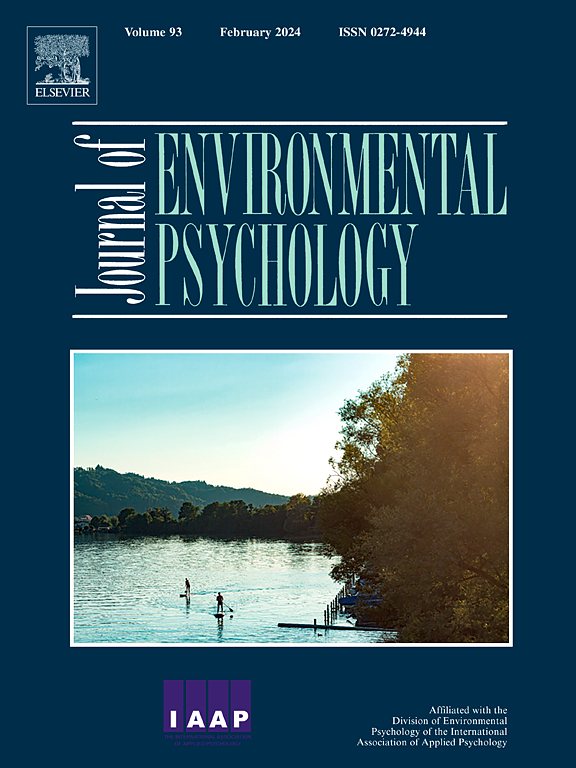Less is more - The effect of VR-induced awe on minimalism and sustainable consumption
IF 7
1区 心理学
Q1 ENVIRONMENTAL STUDIES
引用次数: 0
Abstract
Overconsumption is a major contributor to environmental degradation. To help tackle this problem, across two studies, we investigated the effect of awe on minimalism and sustainable consumption, along with the role of environmental message framing. Additionally, we included different dimensions of self-diminishment as possible mediators and explored the role of construal thinking. In Study 1 (N = 118) and Study 2 (N = 228), participants were randomly assigned to watch a 360-degree video in Virtual Reality (VR) of either the northern lights (awe condition) or a generic forest (neutral condition), paired with either a gain-framed or loss-framed environmental voice-over message. To assess actual behaviour, participants were offered to choose one of several gifts, which were either sustainable or unsustainable. If a participant declined the offer, their behaviour was labelled as minimalistic. Results showed that awe significantly predicted minimalistic behaviour (Study 1) and sustainable consumption behaviour (Study 2), the latter only occurring for novice VR users. No effects were found of message framing or construal thinking. Exploratory analyses showed that the vastness relative to self dimension of self-diminishment mediated the effect of awe on intended and self-reported sustainable consumption. Furthermore, dispositional awe was found to predict intended, self-reported and actual sustainable consumption. We conclude that VR is a useful tool to induce feelings of awe and make people engage in more minimalistic and sustainable consumption behaviours. The underlying mechanisms need to be investigated in future research.
少即是多——vr对极简主义和可持续消费的影响
过度消费是造成环境退化的一个主要因素。为了解决这个问题,在两项研究中,我们调查了敬畏对极简主义和可持续消费的影响,以及环境信息框架的作用。此外,我们将不同维度的自我减少作为可能的中介,并探讨了解释思维的作用。在研究1 (N = 118)和研究2 (N = 228)中,参与者被随机分配观看北极光(敬畏条件)或普通森林(中性条件)的虚拟现实(VR) 360度视频,并搭配增益帧或损失帧的环境画外音信息。为了评估参与者的实际行为,研究人员让他们从几种可持续或不可持续的礼物中选择一种。如果参与者拒绝了这个提议,他们的行为就会被贴上极简主义的标签。结果表明,敬畏显著预测极简主义行为(研究1)和可持续消费行为(研究2),后者仅发生在新手VR用户中。没有发现信息框架或解释思维的影响。探索性分析表明,相对于自我减少的自我维度的浩瀚介导了敬畏对预期和自我报告的可持续消费的影响。此外,气质敬畏被发现预测预期,自我报告和实际可持续消费。我们得出的结论是,VR是一种有用的工具,可以诱导敬畏感,使人们从事更简约和可持续的消费行为。潜在的机制需要在未来的研究中进一步探讨。
本文章由计算机程序翻译,如有差异,请以英文原文为准。
求助全文
约1分钟内获得全文
求助全文
来源期刊

Journal of Environmental Psychology
Multiple-
CiteScore
10.60
自引率
8.70%
发文量
140
审稿时长
62 days
期刊介绍:
The Journal of Environmental Psychology is the premier journal in the field, serving individuals in a wide range of disciplines who have an interest in the scientific study of the transactions and interrelationships between people and their surroundings (including built, social, natural and virtual environments, the use and abuse of nature and natural resources, and sustainability-related behavior). The journal publishes internationally contributed empirical studies and reviews of research on these topics that advance new insights. As an important forum for the field, the journal publishes some of the most influential papers in the discipline that reflect the scientific development of environmental psychology. Contributions on theoretical, methodological, and practical aspects of all human-environment interactions are welcome, along with innovative or interdisciplinary approaches that have a psychological emphasis. Research areas include: •Psychological and behavioral aspects of people and nature •Cognitive mapping, spatial cognition and wayfinding •Ecological consequences of human actions •Theories of place, place attachment, and place identity •Environmental risks and hazards: perception, behavior, and management •Perception and evaluation of buildings and natural landscapes •Effects of physical and natural settings on human cognition and health •Theories of proenvironmental behavior, norms, attitudes, and personality •Psychology of sustainability and climate change •Psychological aspects of resource management and crises •Social use of space: crowding, privacy, territoriality, personal space •Design of, and experiences related to, the physical aspects of workplaces, schools, residences, public buildings and public space
 求助内容:
求助内容: 应助结果提醒方式:
应助结果提醒方式:


